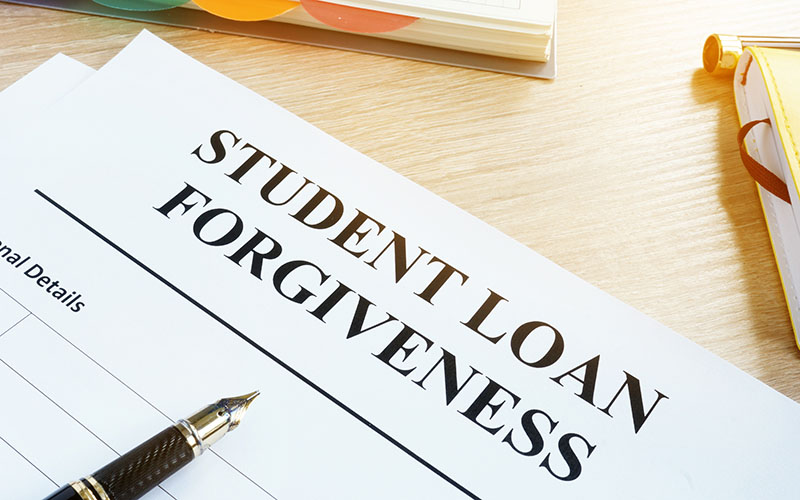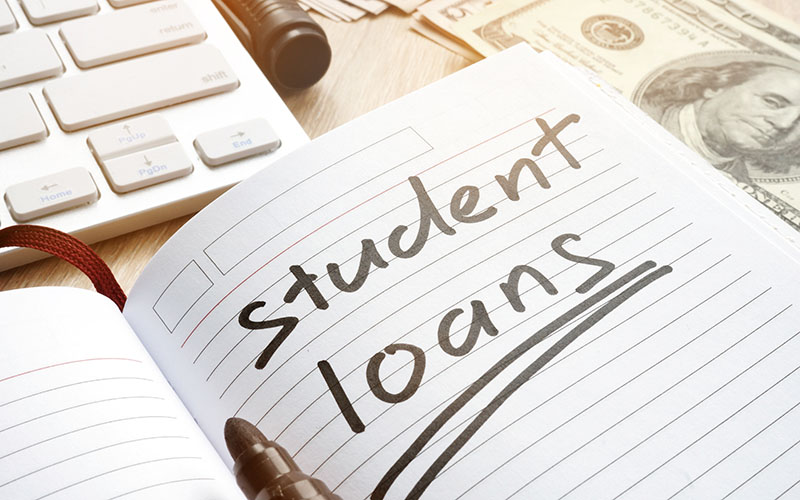How Long Does it Take to Pay Off Student Loans?
Key Takeaways
- There’s no universal timeline for paying off student loans—factors like income, interest, and repayment plans play a major role
- Compounding interest can significantly extend your repayment period, especially with unsubsidized loans
- Federal repayment options—including income-based and extended plans—offer flexible paths to manage debt
- Paying interest while in school and making extra payments can reduce long-term costs and speed up payoff
- Refinancing and employer loan assistance are creative strategies to accelerate student loan repayment

No matter if you’re fresh out of college or years into a post-grad career, you may have one question on your mind–how long does it take to pay off student loans? Unfortunately, there’s no one-size-fits-all answer. Several factors can influence your personal debt repayment process.
At the end of 2018, census data showed that there was up to $1.47 trillion dollars in existing student loan debt. It’s no wonder that so many students (both past and present) feel the financial weight of monthly payments.
Whether you’re on a stable payment plan or struggling to get ahead of compounding interest, this post is for you. You’ll get an in-depth look at factors that affect your repayment schedule, plus options for getting a head start. Learn more about repayment options and federal programs designed to help.
Help! How Long Will it Take Me to Pay Off My Student Loans?

While some loan providers predict that it takes about 10 years to pay off most existing loans, the reality is that it often takes much longer. Recent information shows that the average borrower will need close to 21 years to pay off student loan debt.
Additionally, up to 70% of today’s graduates have some form of student debt. These numbers illustrate the widespread nature of student loan debt. Fortunately, many of these students may be eligible for certain federal programs and options that gradually reduce the burden of debt over time.
To estimate your exact repayment timeline, you should use a student loan repayment calculator. These tools are helpful for understanding your exact financial situation according to income and interest rates. Using calculators also allows you to understand different scenarios and set repayment goals.
Factors that Affect Student Loan Repayment
The repayment process for student loans is extremely unique for each situation. For many people, student loan payments are a heavy burden, but they certainly aren’t the only financial obligation a person has.
Depending on your situation, you may be able to pay only the minimum amount each month.
Employment and income
If your income situation isn’t very stable, it will be difficult to maintain good payments. Additionally, if your job has a lower income, it could be more challenging to get ahead on a payment schedule.
Big picture debt
Do you have other weighty financial obligations? If you have to tackle a large car payment, credit card bills, and other debts, student loans will add more strain.
Industry and aid eligibility
Sometimes, the industry you work in can actually be a plus. Federal programs are designed to help workers in industries like education, healthcare, and public service. If these options are available to you, it could have a positive effect on your repayment process.
Compounding Interest
Compounding interest is one of the reasons that loans take a long period of time to repay. If you used an unsubsidized student loan, interest can accrue from the day the loan is dispersed. This means that interest builds even while a student is in school.
Compound interest means that the amount of interest is added to the principal amount of your loan. While the daily interest amounts may not seem like much at first, the numbers start to add up over the years. Compound interest is what makes many people feel as though they cannot overcome the principal amount, even by making regular payments.
Some options, like the CommonBond student loan, capitalize interest only once. This is a helpful scenario for borrowers who struggle with minimum monthly payments.
Income and Outside Debt
If income is one of the obstacles you face in repaying your student loans, you may need to consider options for refinancing. A refinancing process will take your debt-to-income ratio into consideration. You will also be subject to a credit check to verify credit history and overall financial standing.
The student loan refinancing process can help you consolidate multiple loan payments into one easy monthly payment. It can also lower your total interest rate so that it becomes less of an obstacle. While income doesn’t always predict your financial health, it’s always helpful to know the options that are available at your given income level.
Student Loan Repayment Options
If you have a federal student loan, there are several repayment options available to you. According to studentaid.gov these options can include:
- Standard repayment plan: This plan is fixed monthly payments. It ensures that your loan will be repaid in 10 years (within 10 to 30 years for Consolidation Loans).
- Graduated repayment plan: This option also helps you pay off your loans within 10 years. The main difference is that payments start small and then scale up as time progresses. Borrowers end up paying more under this plan.
- Extended repayment plan: This plan increases your repayment timeline to 25 years. The monthly payments are fixed and are lower than they are on the standard or graduated plan. Eligibility often requires having a loan amount in excess of $30,000.
- Pay As You Earn and Income-Based: These options are based on income and usually require higher levels of debt. Because there could be tax implications with these plans, you should take a careful look at the qualifications and timelines.
Repayment Options During School
To avoid the weight of compounding interest, some financial experts recommend trying to at least pay off the interest while still in school. Although these payments are generally small, it prevents any more money from being added to the principal loan amount.
Paying debt down gradually
Making some small payment while you’re in school can also form a continual habit. Once you graduate, you’ll be less surprised by these payments. You’ll also have done a great service in reducing the principal amount, even if it’s minor.
The federal Student Aid website provides a simplified loan repayment checklist that can help you visualize your options for repayment while in school.
Deferment and Forbearance
Deferment and forbearance are both designed to provide relief for student loan debt. However, they’re both only temporary fixes to a larger debt problem. The main differences are:
Deferment:
- Typically the first course of action when you cannot repay in a timely manner
- Helpful when faced with unemployment or economic hardship
- Utilized during times of transition to a part-time academic program
- Available to military members for times of service and active duty
Forbearance:
- Has two primary types: mandatory and discretionary forbearance
- Helpful for those individuals serving in a medical or dental residency program
- Relevant for people serving in a national service program like AmeriCorps
- Used for teachers who meet eligibility requirements for loan forgiveness
If none of the above options work for you – or you’re simply overwhelmed by the idea of starting to pay down your student debt – read on for some tips for how to get relief, fast.
Ways to Pay Off Your Student Loans Faster
Ready to tackle your student loan debt at a quicker pace? When many people ask, “How long does it take to pay off student loans?” they might be searching for creative options. Try a few of these tips to eliminate student loan debt faster.
- Pay twice a month. If you’ve ever heard of making a bi-monthly mortgage payment, the thought here is the same. A divided payment can cut down on your principal amount over the long run.
- Put your extra cash to work. If you’re really committed to shortening your repayment window, it’s time to get aggressive. When you receive a bonus, tax return, or a gift, you can put this money towards a loan payment. While it might not seem like fun, your future self will thank you!
- Send out your resume. More companies are offering loan repayment assistance as an employee benefit. This is still fairly cutting edge, but the possibilities are out there. You can also bring it up to your current HR team to see if this benefit could be used in place of others.

Know Your Options
Do you want to take a look at creative options for conquering student loan debt? You might need to think outside the box. The Credit Review is home to a variety of resources that can empower you to take control of your debt.
Check out one of our most popular resources, Why You May Need Student Loan Refinancing. In this guide, you’ll learn what refinancing is and how it could shorten the timeline to repaying your student loan debt.
What is the average repayment time for student loans?
According to a popular survey from One Wisconsin Institute, the average time to repay student loans is about 21 years. The average length of time often depends on what kind of degree a student receives and whether they completed that degree. The National Center for Education Statistics (NCES) is a good source for up-to-date information on student loan repayment terms.
What is the average monthly payment for student loans?
Data on the average monthly payment for student loans varies. It’s important to note that this amount has to factor in how much total loan debt a student has. Some research shows that an average monthly payment ranges from $280-$400 each month.
What challenges do students face during repayment?
Former college students may face several challenges during the repayment term.. Individuals with families may struggle to pay another monthly bill in addition to costs like a mortgage, car payment, childcare, and food. Other students may not be able to find moderate or high-income jobs that allow them to tackle debt quickly.
Are there any federal programs designed to help?
Yes, there are several federal programs geared toward providing relief. Many of these programs offer debt forgiveness to people like teachers, public servants, and military members. Some of these programs also apply to parent borrowers who take out federal loans to support their students in college.
What are my options if I can’t repay on time?
Student loans go into delinquency after 30 days of no payment. After a full 9 months of no repayment, the loan goes into default and could be sent to a collection agency. If you’re struggling with repayment, it’s important to communicate with your lender and research available assistance options.
Edited by:
Bryan Huynh
•
Product Tester & Writer









